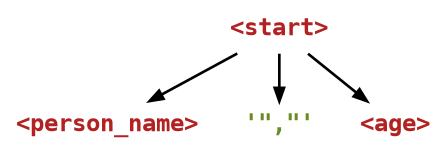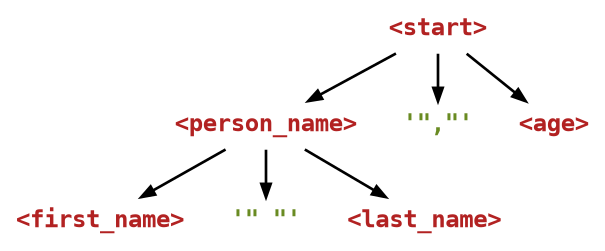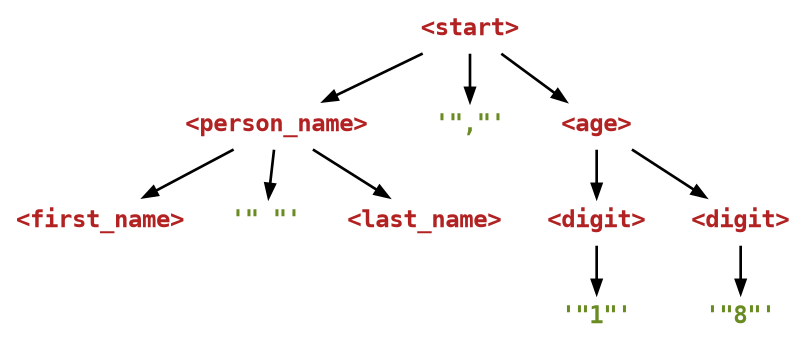Accessing Input Elements#
When dealing with complex input formats, attaching constraints can be complex, as elements can occur multiple times in a generated input. Fandango offers a few mechanisms to disambiguate these, and to specify specific contexts in which to search for elements.
Derivation Trees#
So far, we have always assumed that Fandango generates strings from the grammar. Behind the scenes, though, Fandango creates a far richer data structure - a so-called derivation tree that maintains the structure of the string and allows accessing individual elements. Every time Fandango sees a grammar rule
<symbol> ::= ...
it generates a derivation tree whose root is <symbol> and whose children are the elements of the right-hand side of the rule.
Let’s have a look at our persons.fan spec:
<start> ::= <person_name> "," <age>
<person_name> ::= <first_name> " " <last_name>
<first_name> ::= <name>
<last_name> ::= <name>
<name> ::= <ascii_uppercase_letter><ascii_lowercase_letter>+
<age> ::= <digit>+
The <start> rule says
<start> ::= <person_name> "," <age>
Then, a resulting derivation tree for <start> looks like this:

As Fandango expands more and more symbols, it expands the derivation tree accordingly.
Since the grammar definition for <person_name> says
<person_name> ::= <first_name> " " <last_name>
the above derivation tree would be extended to

And if we next extend <age> and then <digit> based on their definitions
<age> ::= <digit>+
our tree gets to look like this:

Repeating the process, it thus obtains a tree like this:

Note how the tree records the entire history of how it was created - how it was derived, actually.
To obtain a string from the tree, we traverse its children left-to-right,
ignoring all nonterminal symbols (in <...>) and considering only the terminal symbols (in quotes).
This is what we get for the above tree:
Ex Pltz,18
And this is the string Fandango produces. However, viewing the Fandango results as derivation trees allows us to access elements of the Fandango-produced strings and to express constraints on them.
Diagnosing Derivation Trees#
To examine the derivation trees that Fandango produces, use the --format=grammar output format.
This produces the output in a grammar-like format, where children are indented under their respective parents.
As an example, here is how to print a derivation tree from persons.fan:
$ fandango fuzz -f persons.fan -n 1 --format=grammar
<start> ::= <person_name> ',' <age> # Position 0x0000 (0); Sklyi Zzfrxt,0588
<person_name> ::= <first_name> ' ' <last_name> # Position 0x0001 (1); Sklyi Zzfrxt
<first_name> ::= <name>
<name> ::= <ascii_uppercase_letter> <ascii_lowercase_letter> <ascii_lowercase_letter> <ascii_lowercase_letter> <ascii_lowercase_letter> # Sklyi
<ascii_uppercase_letter> ::= <_ascii_uppercase_letter>
<_ascii_uppercase_letter> ::= 'S' # Position 0x0002 (2)
<ascii_lowercase_letter> ::= <_ascii_lowercase_letter>
<_ascii_lowercase_letter> ::= 'k' # Position 0x0003 (3)
<ascii_lowercase_letter> ::= <_ascii_lowercase_letter>
<_ascii_lowercase_letter> ::= 'l' # Position 0x0004 (4)
<ascii_lowercase_letter> ::= <_ascii_lowercase_letter>
<_ascii_lowercase_letter> ::= 'y' # Position 0x0005 (5)
<ascii_lowercase_letter> ::= <_ascii_lowercase_letter>
<_ascii_lowercase_letter> ::= 'i' # Position 0x0006 (6)
<last_name> ::= <name>
<name> ::= <ascii_uppercase_letter> <ascii_lowercase_letter> <ascii_lowercase_letter> <ascii_lowercase_letter> <ascii_lowercase_letter> <ascii_lowercase_letter> # Zzfrxt
<ascii_uppercase_letter> ::= <_ascii_uppercase_letter>
<_ascii_uppercase_letter> ::= 'Z' # Position 0x0007 (7)
<ascii_lowercase_letter> ::= <_ascii_lowercase_letter>
<_ascii_lowercase_letter> ::= 'z' # Position 0x0008 (8)
<ascii_lowercase_letter> ::= <_ascii_lowercase_letter>
<_ascii_lowercase_letter> ::= 'f' # Position 0x0009 (9)
<ascii_lowercase_letter> ::= <_ascii_lowercase_letter>
<_ascii_lowercase_letter> ::= 'r' # Position 0x000a (10)
<ascii_lowercase_letter> ::= <_ascii_lowercase_letter>
<_ascii_lowercase_letter> ::= 'x' # Position 0x000b (11)
<ascii_lowercase_letter> ::= <_ascii_lowercase_letter>
<_ascii_lowercase_letter> ::= 't' # Position 0x000c (12)
<age> ::= <digit> <digit> <digit> <digit> # 0588
<digit> ::= <_digit>
<_digit> ::= '0' # Position 0x000d (13)
<digit> ::= <_digit>
<_digit> ::= '5' # Position 0x000e (14)
<digit> ::= <_digit>
<_digit> ::= '8' # Position 0x000f (15)
<digit> ::= <_digit>
<_digit> ::= '8' # Position 0x0010 (16)
We see how the produced derivation tree consists of a <start> symbol, whose <first_name> and <last_name> children expand into <name> and letters; the <age> symbol expands into <digit> symbols.
The comments (after #) show the individual positions into the input, as well as the values of compound symbols.
What is the full string represented by the above derivation tree?
Solution
It’s 'Pl Seov,5150', as you can find on the right-hand side of the first line.
Tip
The --format=grammar option is great for debugging, especially binary formats.
Specifying Paths#
One effect of Fandango producing derivation trees rather than “just” strings is that we can define special operators that allow us to access subtrees (or sub-elements) of the produced strings - and express constraints on them.
This is especially useful if we want constraints to apply only in specific contexts - say, as part of some element <a>, but not as part of an element <b>.
Accessing Children#
The expression <foo>[N] accesses the N-th child of <foo>, starting with zero.
If <foo> is defined in the grammar as
<foo> ::= <bar> ":" <baz>
then <foo>[0] returns the <bar> element, <foo>[1] returns ":", and <foo>[2] returns the <baz> element.
In our persons.fan derivation tree for Ex Pltz, for instance, <start>[0] would return the <person_name> element ("Ex Pltz"), and <start>[2] would return the <age> element (18).
We can use this to access elements in specific contexts.
For instance, if we want to refer to a <name> element, but only if it is the child of a <first_name> element, we can refer to it as <first_name>[0] - the first child of a <first_name> element:
<first_name> ::= <name>
Here is a constraint that makes Fandango produce first names that end with x:
$ fandango fuzz -f persons.fan -n 10 -c '<first_name>[0].endswith("x")'
Mpzxx Amflv,1
Jxvx Rnqpmu,10
Zvkx Yoz,0
Jx Qz,260
Wodexx Drflhl,7116
Niox Ri,8
Jxvx Mmhbm,10
Noxhmcstx Rjhyuzyteltt,9008050683
Iqjpernx Gklmugke,4545594188
Pvksugebdogcx Xchnqiipnqb,65026731237
Tip
As in Python, you can use negative indexes to refer to the last elements.
<age>[-1], for instance, gives you the last child of an <age> subtree.
Important
While symbols act as strings in many contexts, this is where they differ.
To access the first character of a symbol <foo>, you need to explicitly convert it to a string first, as in str(<foo>)[0].
Slices#
Fandango also allows you to use Python slice syntax to access multiple children at once.
<name>[n:m] returns a new (unnamed) root which has <name>[n], <name>[n + 1], …, <name>[m - 1] as children.
This is useful, for instance, if you want to compare several children against a string:
$ fandango fuzz -f persons-faker.fan -n 10 -c '<name>[0:2] == "Ch"'
Chad Chavez,17230432147844936842763409310951574130700439855580316
Christopher Chambers,48970145445902431245135609507181798505204689
Christian Chandler,0114828291586749565540414906269956981296363474
Christian Chandler,88655699715614927302999150754066433638366
Christopher Church,1085857420005322740848010361964800133151830902
Christopher Church,8107811096268421419204075395057681032962228422
Christina Chan,70170017204875942853352888224368790058095022233547
Christopher Chase,25652972481666085204136400897672718378358169000
Christopher Chase,1085857420005322740848010361964800133151830902
Christopher Chavez,6119709680254971229469133674935431015981770313
Would one also be able to use <start>[0:2] == "Ch" to obtain inputs that all start with "Ch"?
Solution
No, this would not work. Remember that in derivation trees, indexes refer to children, not characters. So, according to the rule
<start> ::= <person_name> "," <age>
<start>[0] is a <person_name>, <start>[1] is a ",", and <start>[2] is an <age>.
Hence, <start>[0:2] refers to <start> itself, which cannot be "Ch".
Indeed, to have the string start with "Ch", you (again) need to convert <start> into a string first, and then access its individual characters:
$ fandango fuzz -f persons-faker.fan -n 10 -c 'str(<start>)[0:2] == "Ch"'
Charles Rivera,78
Cheryl Perry,600
Charles Morrison,5
Christine Davis,008
Charles Molina,27
Charles Ochoa,5
Charles Castro,27
Charles Wilson,27
Christopher Roach,24
Christopher Mills,6
Fandango supports the full Python slice semantics:
An omitted first index defaults to zero, so
<foo>[:2]returns the first two children.An omitted second index defaults to the size of the string being sliced, so
<foo>[2:]returns all children starting with<foo>[2].Both the first and the second index can be negative again.
Selecting Children#
Referring to children by number, as in <foo>[0], can be a bit cumbersome.
This is why in Fandango, you can also refer to elements by name.
The expression <foo>.<bar> allows accessing elements <bar> when they are a direct child of a symbol <foo>.
This requires that <bar> occurs in the grammar rule defining <foo>:
<foo> ::= ...some expansion that has <bar>...
To refer to the <name> element as a direct child of a <first_name> element, you thus write <first_name>.<name>.
This allows you to express the earlier constraint in a possibly more readable form:
$ fandango fuzz -f persons.fan -n 10 -c '<first_name>.<name>.endswith("x")'
Krkvfx Eqpy,36
Dnsx Gnoxq,43513
Iix Hfka,3
Ux Kddr,53405
Mxqx Volzm,6
Nvfex Vygzkv,95503
Iix Ux,3
Iix Hcka,3
Ustax Jacmeseny,9
Teaolcjx Pix,3
Note
You can only access nonterminal children this way; <person_name>." " (the space in the <person_name>) gives an error.
Selecting Descendants#
Often, you want to refer to elements in a particular context set by the enclosing element. This is why in Fandango, you can also refer to descendants.
The expression <foo>..<bar> allows accessing elements <bar> when they are a descendant of a symbol <foo>.
<bar> is a descendant of <foo> if
<bar>is a child of<foo>; orone of
<foo>’s children has<bar>as a descendant.
If that sounds like a recursive definition, that is because it is.
A simpler way to think about <foo>..<bar> may be “All <bar>s that occur within <foo>”.
Let us take a look at some rules in our persons.fan example:
<first_name> ::= <name>
<last_name> ::= <name>
<name> ::= <ascii_uppercase_letter><ascii_lowercase_letter>+
<ascii_uppercase_letter> ::= "A" | "B" | "C" | ... | "Z"
To refer to all <ascii_uppercase_letter> element as descendant of a <first_name> element, you thus write <first_name>..<ascii_uppercase_letter>.
Hence, to make all uppercase letters X, but only as part of a first name, you may write
$ fandango fuzz -f persons.fan -n 10 -c '<first_name>..<ascii_uppercase_letter> == "X"'
Xaqr Ly,755
Xk Ys,6
Xuksjb Ugjh,53807
Xaxow Nspwg,0974
Xxcj Szcnpa,690
Xkqf Aqbmsa,239
Xwue Rs,7424
Xisw Rfa,44219
Xrm Dknm,9916
Xqeb Weqg,133
Chains#
You can freely combine [], ., and .. into chains that select subtrees.
What would the expression <start>[0].<last_name>..<ascii_lowercase_letter> refer to, for instance?
Solution
This is easy:
<start>[0]is the first element of start, hence a<person_name>..<last_name>refers to the child of type<last_name>..<ascii_lowercase_letter>refers to all descendants of type<ascii_lowercase_letter>
Let’s use this in a constraint:
$ fandango fuzz -f persons.fan -n 10 -c '<start>[0].<last_name>..<ascii_lowercase_letter> == "x"'
Nuxsi Vxxxxx,0
Lmaseq Lxxxx,208
Dajc Bxxx,9
Vytrrw Cxxx,1
Raj Tx,7125
Ezsuf Kxx,28597
Rrtpd Cxxx,7673
Tomncz Exxxx,7618
Uvp Tx,8
Uhzejo Qxxxxx,4310
Quantifiers#
By default, whenever you use a symbol <foo> in a constraint, this constraint applies to all occurrences of <foo> in the produced output string.
For your purposes, though, one such instance already may suffice.
This is why Fandango allows expressing quantification in constraints.
Star Expressions#
In Fandango, you can prefix an element with * to obtain a collection of all these elements within an individual string.
Hence, *<name> is a collection of all <name> elements within the generated string.
This syntax can be used in a variety of ways.
For instance, we can have a constraint check whether a particular element is in the collection:
"Pablo" in *<name>
This constraint evaluates to True if any of the values in *<name> (= one of the two <name> elements) is equal to "Pablo".
*-expressions are mostly useful in quantifiers, which we discuss below.
Existential Quantification#
To express that within a particular scope, at least one instance of a symbol must satisfy a constraint, use a *-expression in combination with any():
any(CONSTRAINT for ELEM in *SCOPE)
where
SCOPEis a nonterminal (e.g.<age>);ELEMis a Python variable; andCONSTRAINTis a constraint overELEM
Hence, the expression
any(n.startswith("A") for n in *<name>)
ensures there is at least one element <name> that starts with an “A”:
Let us decompose this expression for a moment:
The expression
for n in *<name>lets Python iterate over*<name>(all<name>objects within a person)…… and evaluate
n.startswith("A")for each of them, resulting in a collection of Boolean values.The Python function
any(list)returnsTrueif at least one element inlistis True.
So, what we get is existential quantification:
$ fandango fuzz -f persons.fan -n 10 -c 'any(n.startswith("A") for n in *<name>)'
Afvr Pfot,425
Kzia Asx,7835
Hu Avyn,98
Akzcrv Fnovi,23
Acxfo Sddghr,07
Ambiw Usj,18
Aj Jdxts,21
Acxvo Sddghr,07
Akzcrv Fnofi,23
Enzdr Axasp,08092
Universal Quantification#
Where there are existential quantifiers, there also are universal quantifiers.
Here we use the Python all() function; all(list) evaluates to True only if all elements in list are True.
We use a *-expression in combination with all():
all(CONSTRAINT for ELEM in *SCOPE)
Hence, the expression
all(c == "a" for c in *<first_name>..<ascii_lowercase_letter>)
ensures that all sub-elements <ascii_lowercase_letter> in <first_name> have the value “a”.
Again, let us decompose this expression:
The expression
for c in *<first_name>..<ascii_lowercase_letter>lets Python iterate over all<ascii_lowercase_letter>objects within<first_name>…… and evaluate
c == "a"for each of them, resulting in a collection of Boolean values.The Python function
all(list)returnsTrueif all elements inlistare True.
So, what we get is universal quantification:
$ fandango fuzz -f persons.fan -n 10 -c 'all(c == "a" for c in *<first_name>..<ascii_lowercase_letter>)'
Jaa Albply,85
Maaa Yp,53165
Aaaaaa Rgx,4
Saaaaa Lj,414
Iaa Pd,34370
Saaaa Zxnh,229
Gaa Gf,7562
Za By,1349
Raaaaa Po,247
Ua Gyep,276
By default, all symbols are universally quantified within <start>, so a dedicated universal quantifier is only needed if you want to limit the scope to some sub-element.
This is what we do here with <first_name>..<ascii_lowercase_letter>, limiting the scope to <first_name>.
Given the default universal quantification, you can actually achieve the same effect as above without all() and without a *. How?
Solution
You can access all <ascii_lowercase_letter> elements within <first_name> directly:
$ fandango fuzz -f persons.fan -n 10 -c '<first_name>..<ascii_lowercase_letter> == "a"'
